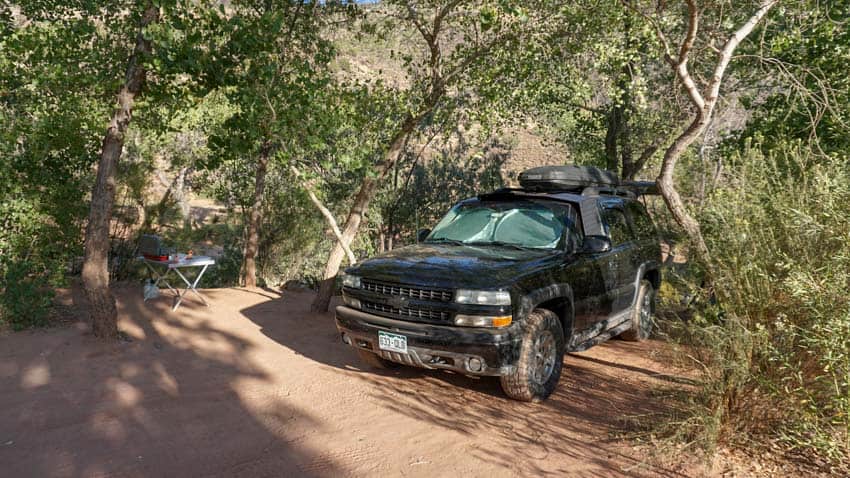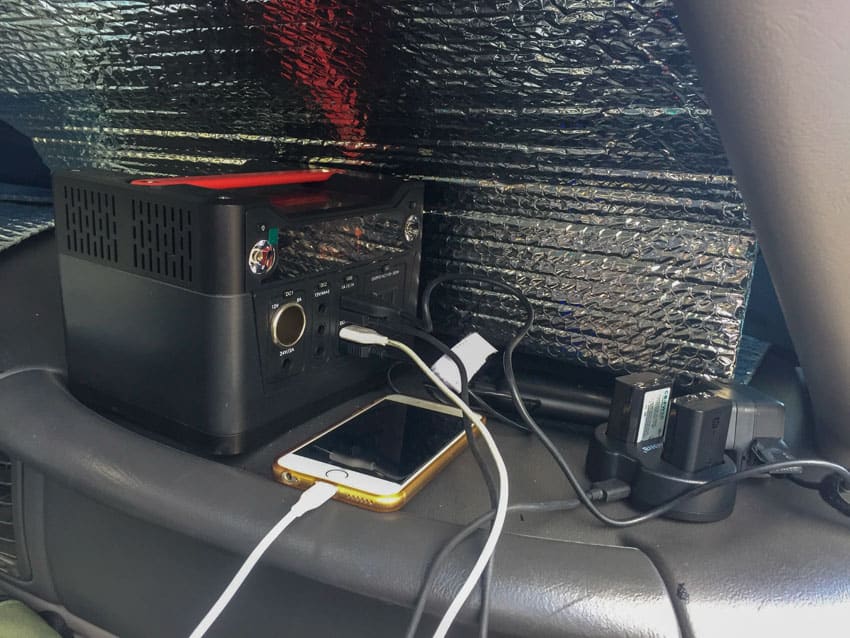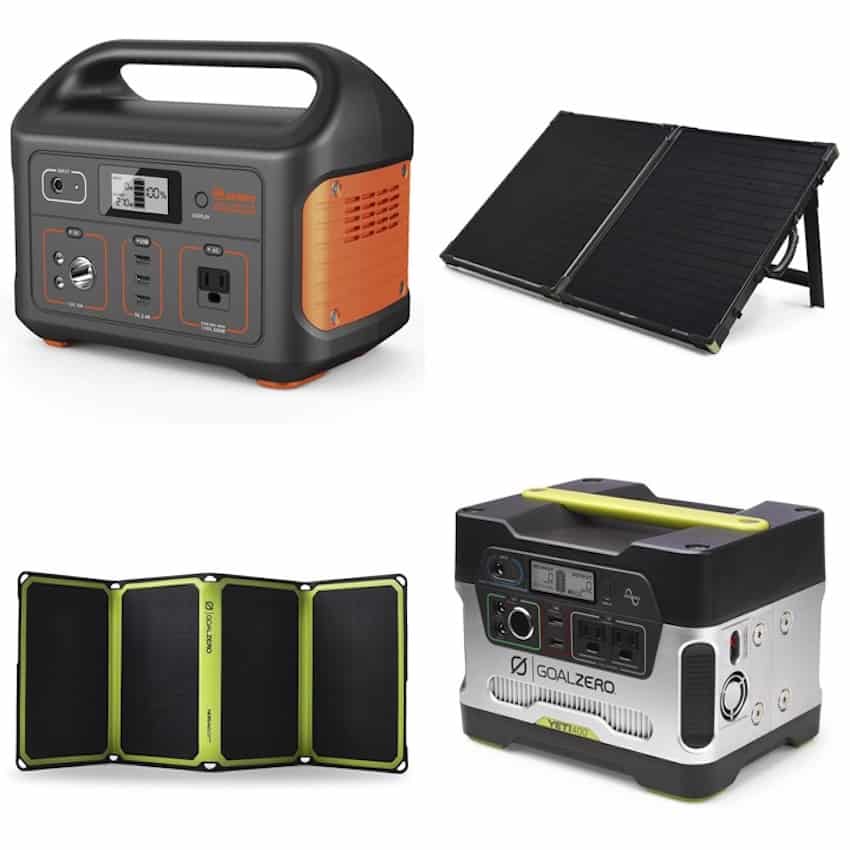As much as I love escaping to the wilderness and leaving all electronics powered down, there are times when you still need a bit of electricity. Maybe you want to keep some lights on, charge your everyday devices, run a small refrigerator, or even make sure your car can start.
It’s time to throw out that noisy, gas-guzzling generator and get in touch with the new reality. Portable Solar Panels.
There’s a whole new world for camping solar panels. There are some more affordable options and some powerful machines which can push the budget. Whatever your needs, there’s something for you.
So ditch the gas generator, bring your electrical toys along, and power them with free, renewable, solar power!

Two Things: Solar Panels and Battery
Harnessing the sun’s energy to create camping solar panels is as easy as two things: solar panels and a battery bank.
First, are the solar panels themselves to harness the power. These are rated by watts. The higher the wattage, the quicker the charge (and the bigger the panels). The solar panels can be fixed in place (like the roof of a vehicle) or there are foldable arrays for more portability. Mine is about the size of an ultra-thin briefcase.
Second, is a battery bank that’s capable of storing the power until you need it. These are usually rated by watts or watt-hours (Wh). To dramatically oversimplify things, smartphone batteries are around 10 Wh and laptop batteries are around 50 Wh. So if your battery bank is around 300 Wh and your laptop takes 50 Wh, you can charge your laptop around 5-6 times.
And with those two basics, you can start to get an idea of what you need for your camping solar panels. Of course, you’ll want to throw in some other small devices to help it run smoothly, such as a power inverter and a solar controller. We’ll get into those details too.

Prebuilt and Custom Solar Panel Options
There are two main ways to go about bringing camping solar power to the wilderness or off-grid situations.
First, there are pre-built packages that can be used directly out of the box with little-to-no electrical knowledge. You figure out what you want, they send you a package with everything you need. Open the box, put the solar panels in the sun, and connect your device to the power bank. Done deal.
Second, you can build a custom setup that meets your exact needs and reduces the budget. You buy the panels, the wires, the controllers, inverter, and everything else. You link it all together, put your panels where you want, and you’re up and running. But have no doubt – this is installing your own electrical grid. It will take some know-how.

Prebuilt Options
I’m a big fan of the prebuilt options. My solar power setup is one of my favorite pieces of camping gear. And there’s no need to become an electrical engineer. I’m pretty sure my mom could even use these.
With most prebuilt options, you select a solar panel array and a portable power station that fit your needs. The power bank often has a built-in power inverter and perhaps multiple outlets of various types (AC plugs, USB ports, 12V plugs).
You can set out the solar panel wherever it’s convenient (or get one to fix in place on top of your vehicle) and charge the battery bank as needed. Then you can bring the battery bank to wherever you need power. On the table, in the car, or wherever else.
Most camping solar panels connect to the power bank directly, especially if they are made by the same manufacturer. If you want to go with different brands, you can often use an MC4 connector to bridge any differences.
Prebuilt Manufacturer Options for Camping Solar Panels
Goal Zero
If you really want plug-and-play capabilities with a reputable brand, look no farther than Goal Zero. This is essentially the “Apple” of solar power. Sleek products with a great reputation. The biggest downfall is that they’re more expensive than most others.
Their starter-level camping solar panels are modest and can help out with charging a phone or other small devices, like a GoPro. That’s Goal Zero’s Switch 10 Recharger with Nomad 7 Solar Panel, which often sells for less than $125. Put it in the sun for about 4 hours and you’ll have enough to charge your phone from dead to full. Not a bad start.
But if you want to get a bit more serious (and put up a bit more cash), then the Goal Zero Yeti 150WH Power Station with the Nomad 28W Plus Solar Panel is a good starter pack for true entry-level solar power. This sucker will charge your smartphone around ten times or give most laptops 1-2 charges. But I hesitate to recommend a 28W solar panel. According to Goal Zero this will “charge a 30Wh battery in a few hours.” So this will likely take about an entire day of sun to power the 150WH power station.

The midrange option – and the one I recommend for most people – is the Goal Zero Yeti 400 Power Station and a Nomad 100W Solar Panel. Now you’re getting more serious. This will charge your phone for a month (40+ charges) or get your laptop up and running 4-5 times. Pretty impressive and if you’re just looking to recharge a few different small electronics regularly, this is a great bet.
You can always mix and match too. Does the Yeti 400Wh seem like overkill but you like the 100W solar panel? Then get the Yeti 150Wh power station with the Nomad 100W Solar Panel.
If you REALLY want to step it up, then go for the Goal Zero Yeti 3000 with the Boulder 200W Solar Panel. Now you’re looking at powering a small refrigerator, tons of electronics, and perhaps a TV or other serious entertainment systems. You can even link up multiple solar panels if you need more power.
Be aware: hairdryers and other devices that use a lot of electricity are usually not compatible with anything except the top-tier power generators. Reach out to Goal Zero’s customer service at 888-794-6250 or support@goalzero.com if you have specific questions.
 | Goal Zero Switch Power Station and Nomad 7 Solar Panel | $ | CHECK PRICE: Amazon |
 | Goal Zero 150Wh Yeti Power Station | $$ | CHECK PRICE: Amazon |
 | Goal Zero 28W Nomad Solar Panel | $$ | CHECK PRICE: Amazon |
 | Goal Zero 400Wh Yeti Power Station | $$$ | CHECK PRICE: Amazon |
 | Goal Zero 100W Nomad Solar Panel | $$$ | CHECK PRICE: Amazon |
 | Goal Zero 3000Wh Yeti Power Station | $$$$$ | CHECK PRICE: Amazon |
 | Goal Zero 200W Boulder Solar Panel | $$$$ | CHECK PRICE: Amazon |

Rockpals Solar Options
This is the brand we went with. They have similar plug-and-play capability as Goal Zero, but with a slightly lower price tag. Not as many options as Goal Zero, although their catalog is quickly growing.
For most people, Rockpals consists of two main options. The first is a beginner-level powerhouse including the 250Wh Portable Generator (power station) and the 60W Foldable Solar Panel. This is a pretty solid option to get you started with your camping solar panels. The 60W panel offers more bang for you buck compared to Goal Zero’s 28W Nomad.
The other option for Rockpals – and one that we went with personally – is the package with the Rockpals 300Wh Generator (power station) and the 100W Foldable solar panel. With a small, lightweight package, Kristina and I keep our laptops charged, all three cameras fully charged, our kindles going, our smartphones, and multiple lights to keep the campsite alive. This is a great package which I highly recommend.
 | Rockpals 250Wh Power Station | $$ | CHECK PRICE: Amazon |
 | Rockpals 60W Solar Panel | $$ | CHECK PRICE: Amazon |
 | Rockpals 300Wh Power Station | $$$ | CHECK PRICE: Amazon |
 | Rockpals 100W Solar Panel | $$$ | CHECK PRICE: Amazon |


Other Camping Solar Panel Manufacturers
There are tons of other options out there for prebuilt solar power. Jackery is one of the other more reputable brands. I chose to go with Rockpals over Jackery because the compatibility between solar panels wasn’t as thoughtless.
If you go with other providers, make sure that whatever you choose is compatible with one another. I highly suggest reaching out to the customer service of the manufacturer to verify before purchasing.
And at that point, you might just look into going fully customized.

Portable Solar Power Custom Options
Maybe the prebuilt options don’t fit your needs. Or the price seems unjustifiable to you. Either way, you can still bring solar power camping. You just need to put in a little elbow grease first.
The custom options for portable solar power are basically limitless, but I’ll walk you through the option I found to be the most popular: the solar-powered house battery. You can put this in your overlanding camping truck or mount it on top of your big RV to get some camping solar power.
This is essentially three steps:
1. You’ll start with a house battery
2. Attach solar panels to it
3. Add a power inverter

Step 1: Solar-Powered House Battery
A house battery is a backup battery that is permanently installed into your car, truck, or RV. Most often, it is linked to the vehicle’s circuit so that the alternator can charge it and the house battery can be used to jump-start the vehicle in emergencies.
You can dig into the details and make your own kit, but I’d say most people are better off going with something like Blue Sea Systems’ Add-a-Battery Kit. The JayCorp Dual Battery Isolation Kit is another great option with a bit more of the gear required.
If you want to piece together your own kit, here is what you’ll need:
- Battery: Usually go with a sealed, deep-cycle battery that matches your vehicle’s existing battery.
- Isolator/relay: Tells the car which battery to charge/use.
- Fuses: Between the connections to the new, house battery.
- Proper wire: You’ll likely need some 4-6 gauge wire.
- Alternator: You may need to install a larger alternator to avoid alternator failure.
The hardest part of this installation is putting the battery somewhere close to your existing battery. If it’s nearby, you’ll only have to run a bit of wire. Googling for “your car house battery location” will often bring up the best location. Sometimes you can squeeze one in under the hood, but more often, people put them in the trunk or cargo area.
Then you run the wires, connect the isolator/relay and fuses, and you’re good to go. Test it in areas where you can get a jump start (or tow) before heading out into the wilderness. Electrical issues can cause nightmares on the road.
Ok, and with that, you’ll have a second battery installed! So what does that give you? A backup battery for starting your car, great. And a power source for your car’s existing electrical system, going to the 12V cigarette lighters. Great start!

Step 2: Solar Panels to Charge Your House Battery
Now that you have the battery bank there, you can plug in the solar panels and keep that sucker charged. Sure, you can use your car as a gas-powered generator, but don’t fall back into bad habits. Save that gas, noise, and pollution and go solar!
Strap, bolt, or set a solar panel on your vehicle and forget about it! You can buy a solar panel to fix in place on top of your RV or vehicle. Or you can go with a foldable, portable option which you can set out wherever you want. Both Goal Zero and Rockpals offer awesome foldable solar panels.
The Renogy 100 Watts 12 Volts Monocrystalline Solar Starter Kit is a great way to get everything you need in one sleek package. It includes all of the basics:
- Solar panel: Don’t skimp here. Get an adequate panel (or two) for your power needs.
- Controller: The power needs to go from the panels through a controller to the battery.
- Proper wire and connectors: You’ll need high-quality wire and some MC4 connectors.

Step 3: Why You Need a Power Inverter
But what if you have devices that don’t plug into the cigarette lighter, such as your laptop or something else which must be plugged into a normal AC wall outlet?
Simple, get a power inverter. Connect it to your house battery and install it wherever you want to plug devices into. You don’t need as heavy gauge of wire for this, so you can run it farther away from the house battery (although you do lose a bit of power by going too far away). Common placement for this is either near the driver’s seat so it can be used while driving, or in the back of the vehicle so you can have access while at the campsite.
There are TONS of power inverter options, but there are two major factors in choosing a great power inverter. First, ideally you want a pure sine wave inverter rather than a modified sine wave one. Certain sophisticated electronics may have difficulty with a modified sine wave inverters.
Second, you’ll probably want one that connects directly to your house battery rather than going through a cigarette lighter. It’ll be a more stable connection which doesn’t rely on one flimsy 12V connection.
The Giandel 2200W power inverter is a pure sine wave power inverter which connects directly to battery terminals. If you want to save some cash and don’t think pure sine is necessary for you, then check out the Krieger 2000W power inverter.
So now you have a second (house) battery installed, that charges itself with the sun’s rays, and can be used to recharge all of your devices! Dream come true!

Camping Solar Panels Summary
If you’re just looking to get something nice and easy to power a few devices while camping, then check out Goal Zero and Rockpals lineups.
Or if you want to take things into your own hands, get yourself a house battery, some solar panels, and a power inverter and you’ll be all set.
Either way, getting your own portable solar panels is easy and an excellent solution to have power while camping.
And that wraps it up for portable solar power. Whether you just need a small boost that fits in your backpack, or an easy-to-use prebuilt option, or a full-scale custom build, solar power is within your reach. So ditch the gas-powered generator and go with a camping solar panel setup as soon as you can!
What do you think is the best way to get solar power while camping? Are you going to mount a solar panel on the roof of your vehicle or do the portable arrays suit you better? Leave a comment below to share!
Like This Post? Pin It!






I would like to put solar batteries in my home, but I lack the necessary understanding. Reading your site was quite pleasant, and I learned a lot about how to install the batteries in my home, which has relieved all of my stress. I appreciate all of your help with your blog.
Glad it helped, Danny! While this post is more specifically about camping solar panels, the fundamentals of solar and batteries are the same for most applications. You also might be interested in reading our post on campervan electrics, since it speaks more to the calculations between solar panels and battery backups. You’ll just need to scale it up for residential use.
you are really a great writer. your solar panel procedure is really great. Solar panel installation is important for saving money and the environment. Solar panel installation is important for saving money and the environment. Solar panels are an excellent way to save money on electricity bills because they generate the electricity you use for your home.
They are a remarkable technology and an important part of working toward sustainable energy. We’re happy to say that we are now utilizing a big array on our van which covers all of our energy needs. Whether in your home, on weekend camping trips, or full-time vanlife, solar energy is where it’s at!
It is actually possible to go camping with any gas generators! I think that’s really a cool idea. Solar Power has advanced so much. I wasn’t aware of the devices you mentioned in this post earlier. But thanks to your post, now I am. I really appreciate the efforts you have taken to post this wonderful blog comment. Thank you.
There are some truly amazing solar devices out there! Hopefully someday soon the gas generators will be a relic from the past. Thanks for the comment, Ajay!